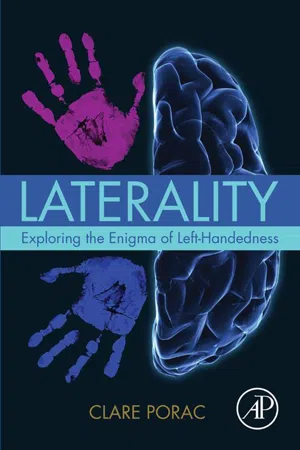
- 232 pages
- English
- ePUB (mobile friendly)
- Available on iOS & Android
About this book
Left-handedness has been connected to many different conditions, traits, and abilities. This is especially true for pathological syndromes, such as schizophrenia, along with learning disabilities and autism. The published research on handedness is vast and frequently contradictory, often raising more questions than providing answers. Questions such as: - Is handedness genetic?- Can handedness be changed?- Are there consequences to training someone to switch handedness?- Are there positive traits associated with left-handedness like creativity?- Are there negative traits associated with left-handedness like trouble reading maps?- Is it abnormal to do some things right-handed and other things left-handed?- Are the brains of left-handers different from the brains of right-handers?Laterality: Exploring the Enigma of Left-Handedness examines the research conducted over the past 50 years with special emphasis on twenty-first century research on handedness and translates this literature into an accessible and readable form. Each chapter is based on a question or questions covering diverse topics such as genetic and biological origins of handedness, familial and hormonal influences on handedness, and the effects of a majority right-handed world on the behaviors of left-handers.- Summarizes scientific research on laterality- Separates fact from fiction in common beliefs about laterality- Includes illustrative interviews with left-handers
Frequently asked questions
- Essential is ideal for learners and professionals who enjoy exploring a wide range of subjects. Access the Essential Library with 800,000+ trusted titles and best-sellers across business, personal growth, and the humanities. Includes unlimited reading time and Standard Read Aloud voice.
- Complete: Perfect for advanced learners and researchers needing full, unrestricted access. Unlock 1.4M+ books across hundreds of subjects, including academic and specialized titles. The Complete Plan also includes advanced features like Premium Read Aloud and Research Assistant.
Please note we cannot support devices running on iOS 13 and Android 7 or earlier. Learn more about using the app.
Information
Everybody’s Right, So What’s Left?
Abstract
Keywords
| Hand preference measures | Hand performance measures | ||
| Strong preference (consistent) | Weak preference (inconsistent) | Hand strength | Hand skill |
| Draw | Comb hair | Grip strength | Place pegs in holes rapidly |
| Write | Pick up book | Dexterity with fingers or tweezers | |
| Throw ball | Screw in light bulb | Tap fingers rapidly | |
| Use scissors | Use pushbutton phone | Maneuver items in rapid sequence | |
| Hammer nail | Wave goodbye | Mark dots rapidly | |
| Thread needle | Pet dog/cat | ||
Hand Preference
| Year | Country | Number of items | Scoring scheme | Two-handed items | Number Tested | All right, % | All left, % | Mixed, % |
| 1927 | USA | 13 | Right, left | Yes | 1474 | 33 | 5 | 62 |
| 1962 | USA | 14 | 5-point scale, Right Always to Left Always | Yes | 1059 | 34 | 20 | 46 |
| 1970 | England | 12 | Right, Either, Left | Yes | 2322 | 68 | 4 | 28 |
| 1971 | Scotland | 10 | ++and +to indicate consistency of Right or Left | Yes | 1128 | 35 | 3 | 62 |
| 1989 | Canada | 60 | 5-point scale, Right Always to Left Always | Yes | 691 | 62 | 5 | 33 |
| 1993 | Canada | 4 | Right, Either, Left | Yes | 3307 | 77 | 4 | 19 |
| 2013 | Australia | 10 | Right, Either, Left | Yes | 3324 | 80 | 6 | 14 |
| Average | 56 | 7 | 37 |
Hand Preference Questionnaires: How Many Questions?
Table of contents
- Cover image
- Title page
- Table of Contents
- Copyright
- Dedication
- Preface
- Acknowledgments
- Chapter 1. Everybody’s Right, So What’s Left?
- Chapter 2. Left in the Genes
- Chapter 3. Who’s Left in the Family?
- Chapter 4. Left-Handers and the Right Mind
- Chapter 5. Left with Raging Hormones
- Chapter 6. Left to Die
- Chapter 7. Left in a Right-Handed World
- Chapter 8. Geography, History, and the Left Hand
- Chapter 9. Disorders, Diseases, and Life on the Left
- Chapter 10. Life on the Left: Not Bad After All
- Chapter 11. More Than a Left Hand
- Chapter 12. Leftovers
- Index

